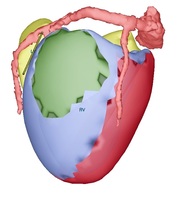Today I stand before you as an engineer, scientist, inventor and entrepreneur. I received my Masters of Science degree in mechanical engineering, in 2010 soon after having completed a B.Tech in mechanical engineering from one of the premier National Institutes of Technology in India, and eventually completed my Ph.D. in biomedical engineering, both from Carnegie Mellon, in 2013. In 2011, I founded QuantMD LLC, originally a brain-child of some cutting-edge new healthcare analytics technology leveraging advanced time-resolved magnetic resonance imaging (MRI) techniques to diagnose coronary heart disease at the earliest possible stage. Today the research areas in which I am published in peer reviewed scientific publications and additionally serve as a scientific reviewer for include biofluids, biomechanics, medical imaging and computational modeling, more or less entirely in the cardiovascular healthcare space. This includes paradigm shifting work that has had application to early detection methods, surgical planning and interventional guidance for treating patients with heart disease, as well as innovative medical devices targeted at improving blood-flow dynamics in young children with congenital heart disease during complex operative procedures.
Technology, innovation and better-care-at-lower-costs for healthcare are the three central drivers that make me tick. Additionally, my efforts for impacting healthcare field and the dedicated focus of my pursuing graduate studies, have been predominantly stimulated by my burning desire to see technologies conventionally innovated and perfected “outside” of the healthcare space (especially in aerospace or automobile industries) applied to medicine, in the clinic. My life’s effort has therefore been founded around the centerpieces of physics based medical image analytics, high performance computational modeling & informatics, the notion of pre-operative surgical planning and finally medical device innovation.
Graduate school in Carnegie Mellon, the extended notion of “freedom” that academia inherently embodies, as well as the opportunities presented as a result of having been being immersed in a productive and innovative academic environment, including the entrepreneurial spirit and grant funding, have all been together central to my rising up in academia from my beginnings as an engineer – one of many – from India. Working hand-in-hand with medical researchers and practicing physicians offered invaluable exposure to research principles that catapulted me into the exciting world of biomedical research. Over the course of my PhD, I was able to leverage the knowledge and experience gained from the worlds of diesel engine combustion modeling for improving brake specific fuel consumptions and engine efficiencies by 1-2 % increments – my early research focus as an undergraduate student in India – in solving complex life-changing biomedical problems in cardiovascular healthcare.
So, what do I engineer these days..? Well, I engineer the pediatric and adult cardiovascular system using high performance computing based vascular blood flow analytics and shape optimization studies. The concept of engineering a better vascular intervention is quite new and comes as a tidal wave of change to the conventional surgical practice, which my close friend and cardiologist colleague often refers to as, "a glorified plumbing job" , through inventive inputs from the engineering world, But at this point let me clarify that I am not a doctor or a surgeon – I am a biomedical engineer applying engineering to cardiovascular medicine. As a “cardiovascular engineer”, my mission has remained steadfast on increasing sensitivity and specificity of contemporary non-invasive diagnostic techniques through novel image-derived biomarkers for primary identification of cardiovascular disease and objectifying decision-making during interventions; therefore enabling better healthcare at lower costs. This idea embodies medical technology of the future which will not only empower cardiologists to administer the right treatment options in a timely fashion but also surgeons to optimize interventional outcomes by way of meticulous intra-operative guidance, using technology that introduces optimization to the science and art of medicine. Such technology has potential to obviate the requirement of several invasive diagnostic procedures, and offer the same results at a fraction of the cost through just non-invasive image data.
Finally, what does It take to succeed as a biomedical engineer..? In addition to a researcher’s productivity, ability to successfully understand and practice engendering a ‘research culture’ is essential– this is also the only way to secure an entrepreneurial future in today’s high-tech research community, and this culture come from graduate school. By ‘research culture’ I mean a combination of strong fundamental knowledge, technical prowess, responsible research conduct and more importantly a lot of motivation for free public showcasing of good science. Another up-side here is that employment of medical scientists is expected to increase at the rapid rate of 36% between 2010 and 2020 – well above the national averages for other professions! Feel free to contact me either via email ([email protected] or [email protected]) or via my website: www.justcallharry.com if you have an interest in biomedical engineering or pursuing a PhD as a graduate student with my research group.
NOTE: this article was also published on DegreeStory.com, and is accessible via the following hyperlink:
http://www.degreestory.com/browse/doctorate/science-engineering/engineering/ph-d-biomedical-engineering-a-final-frontier-a-personal-story-of-rising-up-in-academia-as-a-entrepreneur-impacting-healthcare
 RSS Feed
RSS Feed





